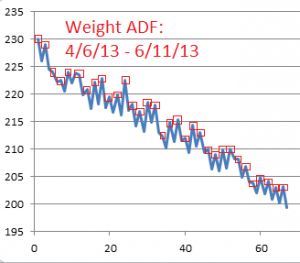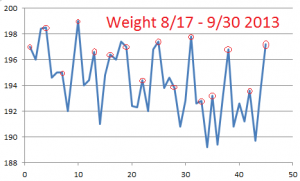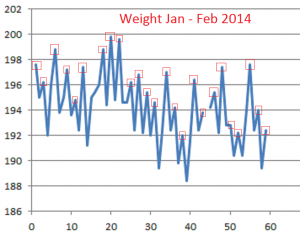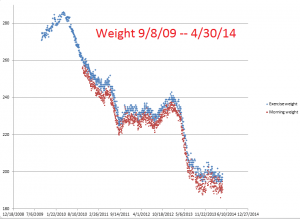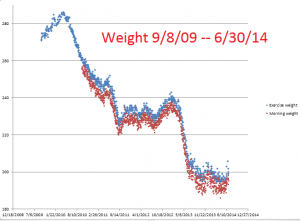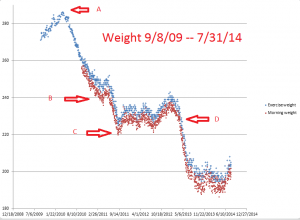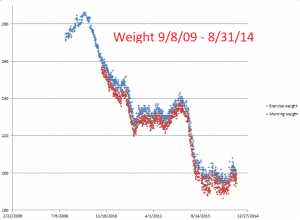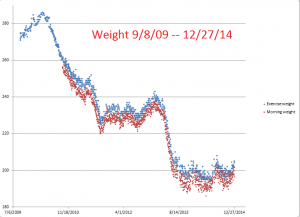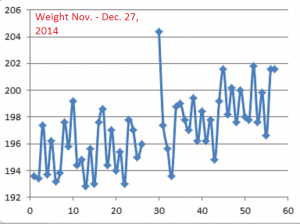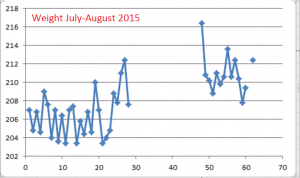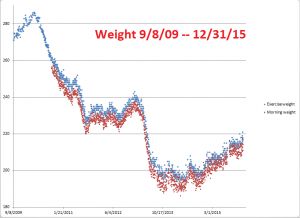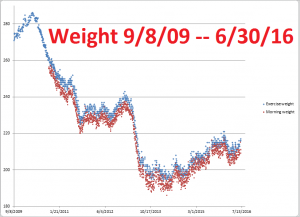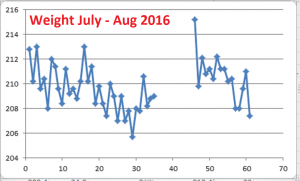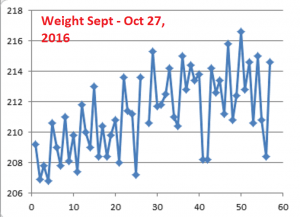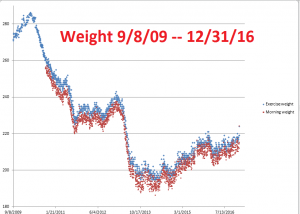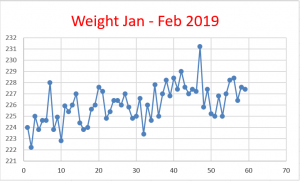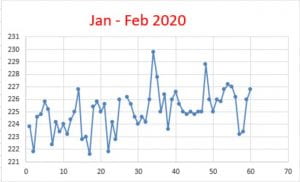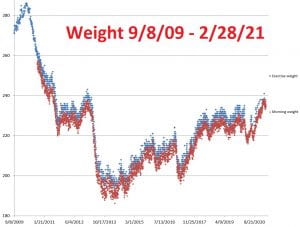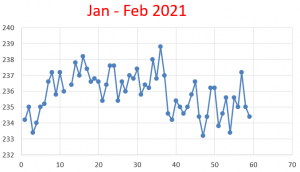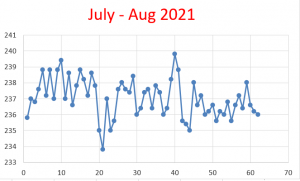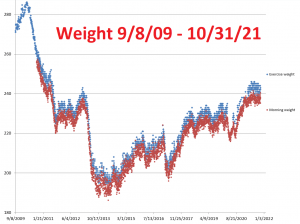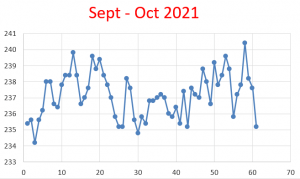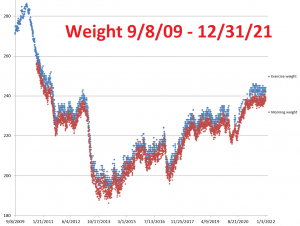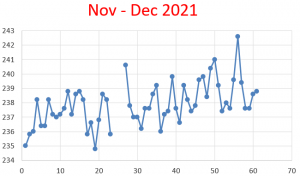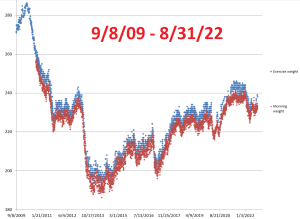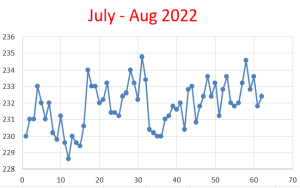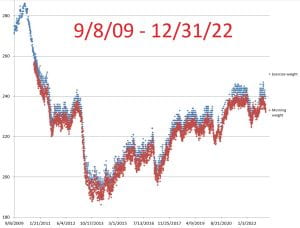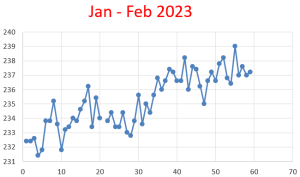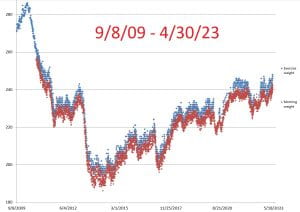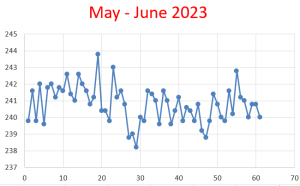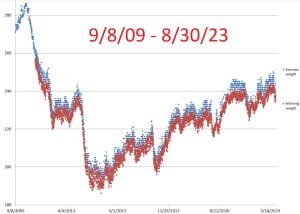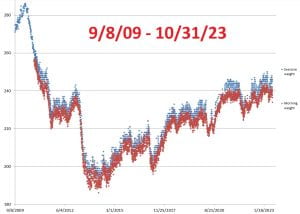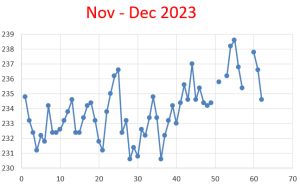Keith DeRose 7/22/13 (with later updates below)
My experience, for the purpose of comparing notes with others.
Brief Early History
I seem to have been a thin kid, sometimes downright skinny. I don’t remember any worries or dissatisfaction with my weight through high school. That may be because I ran cross-country in high school, and so ended up hanging around guys even thinner than me. I do remember in college thinking at times I may have been too thin. During graduate school (age 22-28), I had my first thoughts to the effect that it might be better to weigh less, but for the most part, it wasn’t much of an issue for me. During my next two jobs (ages 28-36) I gradually gained and became problematically overweight.
Initial Episode of Weight Loss and Regained Weight
At about age 35, on the morning after a day of overeating, I tipped the bathroom scale at 254 lbs., a few pounds more than I had ever been. This was a scale which, as I knew, was very “kind”. As near as I can figure, my actual weight was about 270. (I’m 6’1″.) I ate little that day, and the next morning I was a couple of pounds lighter, at 252 on the kind scale. The shocking high weight and the encouraging quick loss probably both reflected temporary changes in how much food was moving through my system at the time, more than any changes that were were likely to last. Still, they together provided me the motivation to finally try to take measures to address my very real problem in a serious way. I resolved to lose weight, and did, by both diet and exercise, bringing my weight down about 45 pounds over the course of about 6 months, and then keeping my weight down there for a few months after that.
As I lost weight, I found I was able to take up running again. (While I was still too heavy for running, I did mostly bike riding.) For a while, I was running 5 miles/day, and finding that, because of that running, I didn’t have to be too careful any longer about my eating to keep my weight steady. But then I got too busy at work, and my running became sporadic, and then pretty much stopped altogether. Meanwhile, the fairly careless eating continued. Over the course of several years my weight crept back up, eventually surpassing what it had been when I was initially scared into losing weight (and making even the thought of running ridiculous). Other signs of ill health showed up in the results of my blood work for my annual physicals and at the physicals themselves, and I was put on medications, first for blood pressure, then for cholesterol.
Starting to Exercise More and Keep Track of Weight
I was going to the gym, mostly to play basketball with my son, or, if he wasn’t with me, just to “shoot around.” My wife would also go, and used her time wisely, mainly using one of the elliptical machines. I would come up from the basketball court to the weight/exercise machine room and lift weights while I waited for her to finish. At some point, I started joining her on a nearby elliptical machine, first for just about 10 minutes or so, and then slowly increasing until I was doing about 36 minutes (which was about how long it took me to do 4 miles on the settings I was using). Being one to keep track of such things, I started bringing a pocket calendar, and recording what I did. The elliptical machine wanted to know my weight, so it could calculate the calories I burned, so I would step on the scale they had there, and enter my weight, and then I recorded my weight along with my settings, time, distance, and calories, on my calendar. In that way, I stumbled onto the important practice of keeping fairly regular track of my weight.
One thing I noticed was that my weight tended to drift up during the winter, and drift down during the summer. As near as I can figure, my body doesn’t like staying at a steady weight, but prefers to be gaining about a pound or more per week, or losing at about that same rate. It seems that where the turn-arounds occurred in the spring and fall were such that I was gaining for more of the year than I was losing, and that’s why my weight kept increasing over the years.
In the summer of 2010 (age 48), as my weight was alarmingly high but going down for the summer, my son, Zack, showed me how to use Excel to enter and then graph what was happening, using my weights as recorded on my exercise calendar. That was the start of this graph:
Losing Weight Again
I could tell just from paging through the weekly calendar that my weight, though bouncing around, had been mostly moving upward through to the end of March 2010, but then had turned downward in early April for my annual summer weight loss. But seeing the dots on the graph that was produced (which at that time was just those blue dots moving upwards for a few months, followed by just the first month or so of downward moving dots) gave me a much better idea of what the pattern was. Though my weight was, as always, bouncing around, there was a quite definite shape to what was happening: though the lines had some width to them, reflecting the bouncing around that was going on, there were pretty clear straight lines, first angling up and then down, emerging on the graph.
I didn’t know what was behind my pattern of losing weight in the summer and gaining in the winter, whether it was the weather, or my schedule. (I’m a philosophy professor, and in the summer, I don’t teach, but just write, and my schedule is “softer,” with fewer times where I have to be somewhere, and so easier for me to control.) But I did see that my weight had gotten alarmingly high at the end of March, before turning down, topping out at 286. Since that was in the afternoon, with gym clothes and shoes on, that was probably equivalent to about 280 pounds with no clothes on, weighed first thing in the morning (when I tend to be lighter). But I also knew that I was scheduled to be on leave from teaching for the coming fall semester. So I thought, given the alarming pattern, this would be a good time to try to lose weight (again). I set a plan to do what I normally did in the summers, only perhaps try to exercise a bit more, and then try to keep my weight loss going through the fall semester all the way to Christmas break.
So I started increasing my time on the elliptical machine until I was doing it for about an hour per day (about 6 days per week), working very hard for that hour. And I tried to be careful in various ways about my eating. As the chart shows, that worked very well, with my weight going down not just through Christmas 2010, but through to the end of March 2011, bottoming out then more than 40 pounds below its high point. At around where I’d lost 25-30 pounds, my wife reported that my snoring had stopped. Aligned with that, I was feeling more rested when I woke in the mornings. As you can see, toward the end of September 2010, red dots join the blue ones. That’s when I opened and started using a home digital scale I had received as a gift (I think I had asked for it, but then neglected to use it for quite a while), recording my weight every day. (I actually weigh myself at home twice every day, morning and night, and record both weights, but only the morning weigh-in makes this chart — as the red dots.) The red dots are below the blue ones, because they are my morning weigh-in, done without clothes or shoes, so the red dot on a typical day is about 5 or so pounds below that day’s “exercise weight.”
I experienced what seemed to me a strange upturn in my weight in April 2011 — strange because I seemed to be keeping to the same regimen that had been working so well. This foreshadowed troubles to come.
But starting around the beginning of May, my weight started going back down again. I don’t know if this is because I was worried about the upturn, and started to be still more careful in my eating, or whether this was just my annual summer weight loss kicking in, a bit later than usual. But in any case, my weight started going down again, eventually bottoming out at the end of August 2011 at 220 morning / 225 exercise weight, about 60 pounds below where my weight had been at its height in March 2010. My doctor was very pleased at my physical, and I was taken off my blood pressure medication, though I remained on the cholesterol med.
Struggle
Then began a long period of struggle. My weight bounced up alarmingly in September 2011. It was alarming in part because I was continuing with the same exercise and careful eating that had been working so well. One thing I think I have learned about weight loss is that the same regimen that works for losing weight when you’re heavy won’t work as well (or perhaps at all) when you’re considerably lighter. That seems to be in part just because you naturally need fewer calories just to maintain your weight when you weigh less. But that would only explain why my weight didn’t continue to go down; it couldn’t explain how, keeping the same regimen going, my weight would suddenly bounce back up so alarmingly. I suppose that could just be chalked up to my seasonal pattern of gaining weight in the Fall/Winter, but to me, because the bounce was so unusually sharp, this also seems to be going on: Sometimes, I think, when you lose weight, your (or at least my) body freaks out, thinking that it’s starving, and starts to “try,” as it were, to gain weight back, with some of its efforts not going to try to make you eat more (which efforts one can resist), but to slow down your metabolism. Or something. I didn’t and don’t really understand what was happening there, but what had been working was for some reason clearly no longer working. [So, there appears to be some research suggesting that metabolic changes are caused by weight loss that make it hard to keep the weight off. Some of this research is reported on in this New York Times piece by Tara Parker-Pope. See esp. the 6 paragraphs that begin with the sentence “Leibel and his colleague Michael Rosenbaum have pioneered much of what we know about the body’s response to weight loss.” I didn’t see there any suggestion of the kind of almost violent “freak-out” I’m conveniently positing here, though.]
I didn’t give up. I started tweaking things, increasing my exercise a bit, and being more disciplined in my eating. These efforts were important, I think, but they didn’t put me back on the path of weight loss, but just stopped my freaking-out body from gaining weight quickly. The chart shows the long struggle from September 2011 through March 2013, with my old gain-and-loss seasonal patterns seeming to emerge again. But this was not a matter of me going back to my old ways, but rather of sticking with, and even ramping up, the efforts at weight control that had been so successful before, but were now floundering.
The latter part of 2012 was especially discouraging. You can see that from May through the beginning of July of that year, I had something of my usual summer weight loss, but the “line” going down, if it can even be called that, is very thick: it was a slow, unusually meandering weight loss pattern. And then it ended very unusually early. At about the 20th of July, my weight bottomed out at about 225 (using only the red dots, from now on), and started back up, and it climbed all the way through the end of 2012, ending at about 235 lbs (with some morning weigh-ins higher than that, some lower, but that’s about the middle of red line at the height of that period of weight gain). Happily, for some reason I cannot begin to understand, my weight started heading down at the beginning of calendar year 2013, which is a very weird time of year (for me) for weight loss to begin. From the beginning of the year 2013 through the beginning of April, I had a fairly good downward line going, but, as you can understand, I was still a bit confused and discouraged. Though my weight was heading down nicely at the time, looking at the chart, I had every reason to think that, despite following a fairly rigorous regimen, I was back on an up-and-down pattern that ominously looked to be tending toward bigger ups than downs.
Intermittent Fasting
Then one evening in early April, I was doing some light work on my computer at home (replying to emails) with the TV on in the background, when a show about weight loss came on PBS. It was “Eat, Fast, and Live Longer,” produced by BBC, in which the British journalist and physician Michael Mosley checks recent research on, and also tries himself, various ways of trying to control weight and remain healthy. If you want, you can watch the show here:
https://vimeo.com/170735109
The last 20 minutes or so of the show (from about 37:00 to the end) is on intermittent fasting. Mosley reported on some research, mostly on alternate day fasting, in which one “fasts” every other day, and how effective that was in losing weight — and also, it seems, in producing other health benefits. He decided to himself try a more moderate form of intermittent fasting, 5/2, where one fasts two days per week, and he seems to have gotten very good results. It sounded like something that would be worth at least trying, especially because the “fast” days involved weren’t days where one didn’t eat anything, but just days on which one ingested highly limited calories: 500 for women and 600 for men. So the next day, I tried a “fasting” day to see how it was. It seemed not so bad, and my weight went down an even 4 pounds from one morning weigh-in to the next. So I decided to continue trying intermittent fasting, but I didn’t yet decide what form it would take for me. But the next day would definitely be a non-fasting day. The idea behind alternate day fasting, as it was presented on the show, was that you could eat whatever you want on your non-fasting days, and yet the people who tried it still seemed to get very good results. (I never saw exactly how things like 5/2, which Mosley ended up doing, were supposed to work in terms of what the non-fasting days were supposed to be like: were they eating whatever they wanted 5 days/wk?!) So the next day, I ate what I wanted–and gained 3 of the 4 lost pounds back. So I “fasted” again on the following day.
I ended up following a very rigorous intermittent fasting program for a little over two months (April 6 through June 10), in which I not only fasted every other day, but, aside from that first non-fasting day, tried to be careful about my eating on non-fasting days in the way I had become used to being (and that had resulted in weight loss for the first few months of 2013). And I also kept up my exercise, doing a solid hour of aerobic exercise (usually on an elliptical machine, or, about once per week, running), working very hard for that hour, about 6 times per week. The results are shown in this chart:
As the chart shows, my weight fluctuated pretty wildly, often going down 3 pounds or so on a fast day, and then going up two pounds or so on many of the non-fast days. That was puzzling, since I was being careful on those non-fast days. Here’s how I came to think of what was happening that seems to make sense of it: When, say, I lost three-and-a-half pounds on a fast day and then gained, say, two-and-a-half pounds on the following non-fast day, I was “really” only losing about one pound on the fast day, and then “really” staying approximately steady on the non-fast day. In addition to the “real” loss of a pound on the fast day, I was also getting a temporary (non-real) extra two-and-a-half pounds of loss from there being less food (and water absorbed in that food) than usual working its way through my system. Then, on the non-fast day, while I was “really” staying steady, I was also gaining back that two-and-a-half pounds of unreal loss from the day before, as I got back up to having a more normal amount of food making its way through my system.
At any rate, I lost 30 pounds during that period of just over 2 months, getting my weight down below 200 pounds, to the lowest it has been in many years. I had blood work done and then saw my doctor for my annual physical, and everything looks great, and I am now off my cholesterol med as well as the med for blood pressure. I am pill-free and seem to be healthy.
So, intermittent fasting was very effective for me. But I don’t think that I would find it sustainable, at least in the fairly extreme form in which I did it for that period of a little over two months. Others seem to have gotten good results with more moderate forms of intermittent fasting, and I too will have to find something more moderate that can work for me on a more sustainable basis, but I felt I had been far too fat for far too long, and I was anxious to get my weight down fast.
Looking Forward: Grounds for Pessimism
The smart money says my weight story ends badly. First, generally, there are lots of people who lose lots of weight, and almost all of them gain at least most of it back, and disturbingly many end up gaining more than all of it back. Some people do lose lots of weight and then keep it off permanently (well, you know, in the sense that anything in this life can be permanent), and the number of such successes seems to be increasing over time, but to succeed in keeping significant amounts of weight off is still very much to be an outlier. Second, I in particular have lost a significant amount of weight in the past, only to gain it all back and then some.
Looking Forward: Grounds for Optimism
Are there reasons for thinking I might be among the outliers? I’ll give a reason to think I might have a better chance than last time at keeping the weight off in the last (“Advice”) section, below. But the main reasons for optimism are these. First, among the 80 pounds that I have lost since the middle of March 2010 are a bit over 40 pounds that I have both lost and then kept off for over two years now. I don’t know enough about how all this works to know how good a reason this is for optimism, but at some point such evidence of keeping lost weight off becomes a decent reason for thinking one is or is likely on one’s way to being an outlier. Second, I have now found the strategy of intermittent fasting, and found that it works well for me, and I now have the below plan, which I have some reason to think I can stick to, and which looks like it should be able to keep me at a reasonable weight. I am now a lot less pessimistic about my long-term chances that I was just a few months ago — and seemingly with good reason.
My Current Plan
My current plan is to permanently follow these rules, based on my morning weigh-ins:
-If I’m over 200 lbs., it’s a fast day iff the previous day was a non-fast day
-If I’m over 190 but not over 200 lbs,. it’s a fast day iff both of the previous two days were non-fast days
-If I’m not over 190 lbs., it’s a fast day iff all of the previous 6 days were non-fast days.
So, basically, I have used every-other-day fasting to get down to 200 pounds, and will use it again whenever I go over that. But I’m now easing up to an every-third-day regimen for the 190-200 pound range. Hopefully, I’ll continue to lose weight on that, even if a bit more slowly. And once I get below 190, the plan is to fast once a week, even if it isn’t needed to stay below 190. (This is in part because there is reason to think there may be health benefits beyond weight control [largely cognitive benefits] associated with intermittent fasting, and also in part because I find intermittent fasting to be a good exercise, in large part because it makes me more cognizant of how blessed I am.)
A Piece of Advice
Only time will tell if the above will work, and I admit the smart money is against me. So I’m really in no position to give anybody any advice at this point. And, really, everybody’s different, anyway. I’m just putting my story out there, and people can take from it what seems to make sense for them.
There is, though, one thing that I think I’ve learned that I will give as a piece of advice that people might at least consider doing themselves. As I’ve said, I’ve lost weight before, only to gain it all back. One thing that I plan to do differently this time is that I will continue to weigh myself every day, and keep track of the results. This has proved very important through my ups and downs these past few years. As long as I am at least fairly clearly facing whatever weight problems I might be having, rather than hiding from them, I seem to increase the chances that I will respond effectively. So I have resolved to keep track of my weight — through thick and thin.
Since my weight does always bounce around a lot, it’s important for me not to over-react to daily fluctuations. But before I started recording my weight, this bouncing around also made it too easy to deny bad news: I could latch onto the readings on down days as evidence that things weren’t so bad, and brush aside the alarming readings on up days–with some justification–with the thought “Well, it bounces around; I shouldn’t get too alarmed.” The best way I’ve found to get a good idea of what’s going on is to not only step on the scale frequently, but keep track of the results: write it down; keep some kind of record; look that record over to discern disturbing trends from noisy fluctuations.
Others might consider doing likewise. I put that out especially for the consideration of young adults who might possibly spare themselves the need to ever have to deal with serious weight problems by facing those problems before they become big and serious, but I think a lot of people who are already struggling with weight problems could also find this very helpful. You don’t need to set up any Excel sheets and make charts and graphs (though that’s also good!): just a sheet of paper with dates and weights will do, or little numbers on your calendar, if you keep old calendars after their years are over. Depending on your situation, and especially if you don’t yet have significant weight problems, recording your weight every day might be overkill for you. But you should perhaps consider keeping a weekly (perhaps every Sunday morning), or perhaps monthly (the morning of the 1st day of every month) record? I suspect that could end up helping a lot of people.
.
Update 7/31/13:
Update 9/30/13:
Update 1/2/14:
Update, 3/19/14 (forgot until then to update):
Update, 5/1/14:
Update, end of June, 2014:
Update 8/1/14
So here is my weight chart:
There are many ups and downs (thankfully, more downs than ups, all told), but from my point of view, other than at point A, where I started trying to lose weight, and point D, where I started intermittent fasting, the changes in direction are not due to changes in my effort: there’s been no giving up or even easing up. From point A to point D, I kept up my efforts, the only changes being in little increases in them (increasing exercise, decreasing eating). From A to C, I was mostly losing weight at a pretty good clip — except for a very frustrating period at B. Then at C, what I was doing no longer worked, my weight shot up a bit, and then I wrestled it up and down. Then at D, I started intermittent fasting, and that worked very well — for a while. A year ago, I was thinking I could just ride intermittent fasting to my goal (below 190 lbs.), and then could ease up to maybe 2 fasting days per week to keep my weight where I wanted it. But then, right around my goal, intermittent fasting stopped working, at least in lowering my weight further: it seemed needed just to keep it from shooting back up further than it did. I’ve basically had to keep fasting 3 days per week just to maintain, and still, the last couple of months it shot up in an alarming way, despite everything. The last week or so, there are signs that it may be turning around to head down again. So I do have some hope that maybe I’ll be breaking through a floor of sorts, my weight will go back down, get below 190, and allow me to perhaps go down to 2 fast days per week. But that’s just a hope. There’s also cause for concern: this could also just be a pause before it starts going up again.
Later Updates:
Update, end of August, 2014:
Update, end of October, 2014:
Update, end of December, 2014:
Update, end of February, 2015:
Update, end of April, 2015:
Update, end of June, 2015:
Update, end of August, 2015:
Update, end of October 2015:
Update, end of December 2015:
Update, end of February 2016:
Update, end of April 2016:
Update, end of June 2016:
Update, end of August 2016:
Update, 10/27/16:
Update, 12/31/16:
Note 3/31/17: There was a significant drop reported in the J-F chart above. (So much so that the y-axis is marked out by 5-pound intervals, rather than the usual 2.) At the day the red arrow is pointed at, I began an experiment with a diet very low in carbs. I’m not sure what role that played. As you can see, I had already started a downward trend before beginning that diet, but it may have played a role in the trend continuing and picking up speed — at least for a while. As of today (3/31), I’ve eased up a bit on the “very low carbs,” but it’s still “quite low”, I’d say — and my carb intake is much lower than it’s ever been before this experiment. But I really don’t know what role if any that is playing. As usual, I have no idea what’s going on.
Update 4/30/17:
Update 6/30/17:
Update 8/31/17:
Update 10/31/17:
Update 12/31/17:
Update 2/28/18:
Update 4/30/18:
Update 6/30/18:
Update 8/31/18:
Update 10/31/18:
Update 12/31/18:
Update 2/28/19:
Update 4/30/19:
Update 7/1/19:
Update 8/31/19:
10 years:
Update, 10/31/19:
Update, 12/31/19:
Update, 2/29/20:
Update, 4/30/20:
Update, 6/30/20:
Update, 8/31/20:
Update, 10/31/20:
Update, 12/31/20:
Update, 2/28/21:
Update, 4/30/21:
Update, 6/30/21:
Update, 8/31/21:
Update, 10/31/21:
Update, 12/31/21:
Update, 2/28/22:
Update, 4/30/22:
Update, 6/30/22:
Update, 8/31/22:
Update, 10/31/22:
Update, 12/31/22:
Update, 2/28/23:
Update, 4/30/23:
Update, 6/30/23:
Update, 8/31/23:
Update, 10/31/23:

